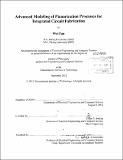Advanced modeling of planarization processes for integrated circuit fabrication
Author(s)
Fan, Wei, Ph. D. Massachusetts Institute of Technology
DownloadFull printable version (28.13Mb)
Other Contributors
Massachusetts Institute of Technology. Department of Electrical Engineering and Computer Science.
Advisor
Duane S. Boning.
Terms of use
Metadata
Show full item recordAbstract
Planarization processes are a key enabling technology for continued performance and density improvements in integrated circuits (ICs). Dielectric material planarization is widely used in front-end-of-line (FEOL) processing for device isolation and in back-end-of-line (BEOL) processing for interconnection. This thesis studies the physical mechanisms and variations in the planarization using chemical mechanical polishing (CMP). The major achievement and contribution of this work is a systematic methodology to physically model and characterize the non-uniformities in the CMP process. To characterize polishing mechanisms at different length scales, physical CMP models are developed in three levels: wafer-level, die-level and particle-level. The wafer-level model investigates the CMP tool effects on wafer-level pressure non-uniformity. The die-level model is developed to study chip-scale non-uniformity induced by layout pattern density dependence and CMP pad properties. The particle-level model focuses on the contact mechanism between pad asperities and the wafer. Two model integration approaches are proposed to connect wafer-level and particle-level models to the die-level model, so that CMP system impacts on die-level uniformity and feature size dependence are considered. The models are applied to characterize and simulate CMP processes by fitting polishing experiment data and extracting physical model parameters. A series of physical measurement approaches are developed to characterize CMP pad properties and verify physical model assumptions. Pad asperity modulus and characteristic asperity height are measured by nanoindentation and microprofilometry, respectively. Pad aging effect is investigated by comparing physical measurement results at different pad usage stages. Results show that in-situ conditioning keeps pad surface properties consistent to perform polishing up to 16 hours, even in the face of substantial pad wear during extended polishing. The CMP mechanisms identified from modeling and physical characterization are applied to explore an alternative polishing process, referred to as pad-in-a-bottle (PIB). A critical challenge related to applied pressure using pad-in-a-bottle polishing is predicted.
Description
Thesis (Ph. D.)--Massachusetts Institute of Technology, Dept. of Electrical Engineering and Computer Science, 2012. Cataloged from PDF version of thesis. Includes bibliographical references (p. 215-225).
Date issued
2012Department
Massachusetts Institute of Technology. Department of Electrical Engineering and Computer SciencePublisher
Massachusetts Institute of Technology
Keywords
Electrical Engineering and Computer Science.